How An Auburn University Student Program Is Revitalizing Rural Alabama
- Oops!Something went wrong.Please try again later.
Auburn Rural Studio student architecture program has been making a difference for 30 years.
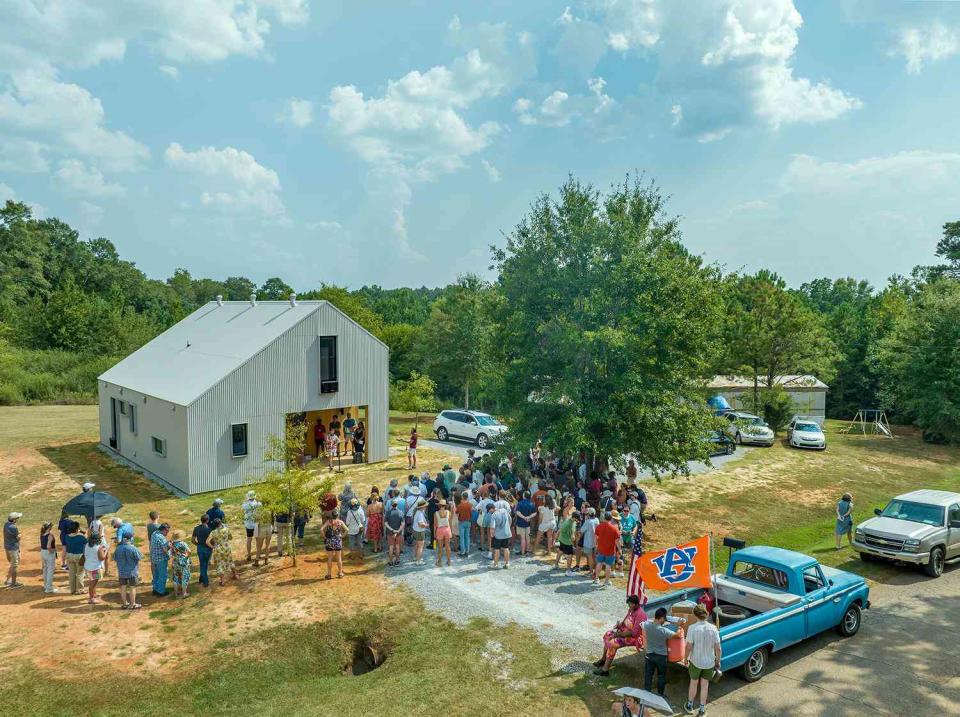
Timothy Hursley
If you drive south down State 69 from Tuscaloosa and look out your window, you won’t see much. The University of Alabama’s grand campus of stately brick buildings and mega-mansion sorority houses fades to farmland. Cemeteries, a sprinkling of churches, and little else blur by until you finally reach Greensboro, Alabama’s lively but diminutive main street. From there, turn onto State 61, and traverse another 10 miles of countryside to Newbern (with a population of about 130), where Auburn University’s Rural Studio springs up like a dandelion in a clover field.
From this 5-acre plot deep in Alabama’s Black Belt, more than 1,250 undergraduate architecture students have dreamed up the plans for 220 homes and public buildings that, over the past three decades, have become part of the fabric of Hale County. Rural Studio is a proven experiment in symbiotic cohabitation. Students in their third and fifth years of Auburn’s architecture program receive an invaluable education with hands-on work and civic engagement, while locals benefit from a welcome influx of affordable housing and imaginative community spaces.
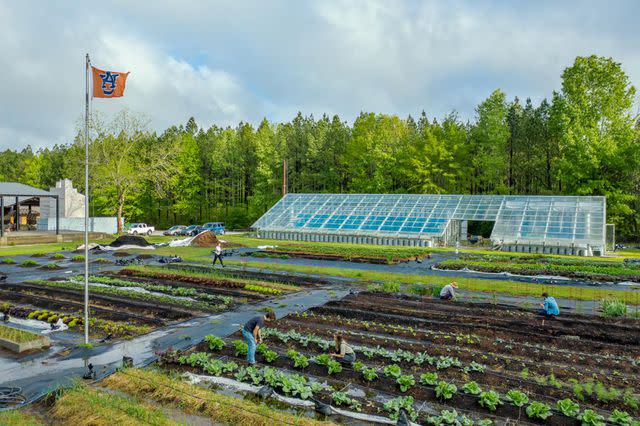
Timothy Hursley
Rural Studio's campus in Newbern, Alabama includes a small urban-style farm that is cared for by student architects.Home Base
Rural Studio’s campus is dominated by an 1890s farmhouse that’s supplemented by modern additions (like a gabled dogtrot and commercial kitchen), a futuristic glass greenhouse, and a garden. Students live, work, play, and grow during their time here. Under a grand pavilion, dubbed the Great Hall, they gather for family-style meals at an extra-long table crowded with their peers, faculty, and staff. Most days, the dishes incorporate fruits and vegetables harvested from the on-site farm.
Behind the Great Hall is a cluster of small homes (called pods) that serve as dorms, where participants have wasted no time in getting comfortable. The covered brick thoroughfare connecting the pods is littered with folding chairs, bug spray, dog-eared novels, half-full mugs of coffee, and playing cards. Hammocks are strung from support beams, and drawing books are scattered across a dilapidated table tennis setup. At the end of the row, a larger pod is the former home of the late Samuel Mockbee, who cofounded Rural Studio in 1993.
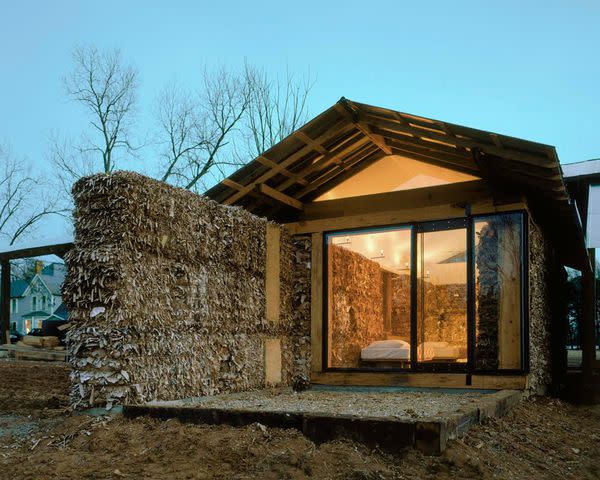
A Clear Vision
Imagine a scene from the movie Dead Poets Society with Mockbee playing John Keating, Robin Williams’ beloved role as an unconventional English teacher. Keating lived among his pupils and inspired them to greatness. So, too, did Mockbee. The program’s patriarch passed away in 2001, but his drive, energy, and revolutionary vision for Rural Studio have continued to shape every person and project that has come from it since.
Mockbee’s influence was pivotal from the beginning. Andrew Freear, a native of England, saw him give a lecture in Chicago in the late 1990s. A year or so later, Freear applied for a job at Auburn and, after Mockbee’s death, went on to become the director of Rural Studio. “I admired him,” Freear says. “I hadn’t really seen someone speak so articulately and be so passionate about bringing architecture to everybody—not just to the wealthy 3%.”
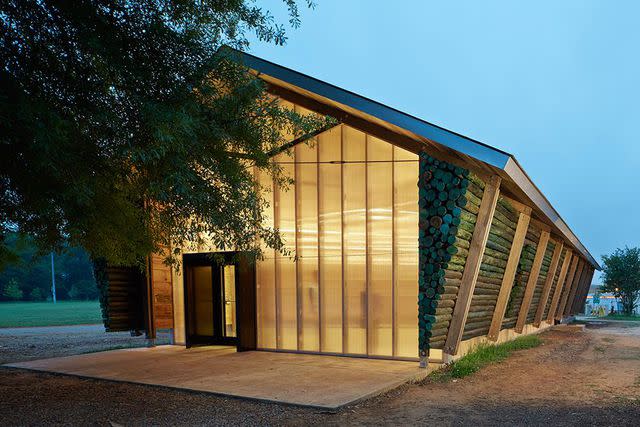
Timothy Hursley
The Scout Hut in Lions Park, built in 2012, hosts local groups.The Full Picture
Freear says that Rural Studio is about more than constructing interesting buildings in small-town Alabama. That isn’t what won Mockbee a MacArthur Fellowship in 2000, and it isn’t what has kept the model successful for so long. Instead, the program focuses on addressing the full range of challenges that often plague rural areas. Affordable homeownership is a big piece of the puzzle, but so is having access to reliable wastewater systems, nutritious produce, and public resources.
Their farm helps alleviate the fresh-food shortage by donating excess crops to a pay-what-you-can stand in Greensboro. Meanwhile, program alumnus and third-year instructor Emily McGlohn is working alongside a consortium of stakeholders—including the office of Senator Katie Britt, the Alabama Department of Environmental Management, and a few universities—to bring a new wastewater-treatment system to Newbern and places like it.
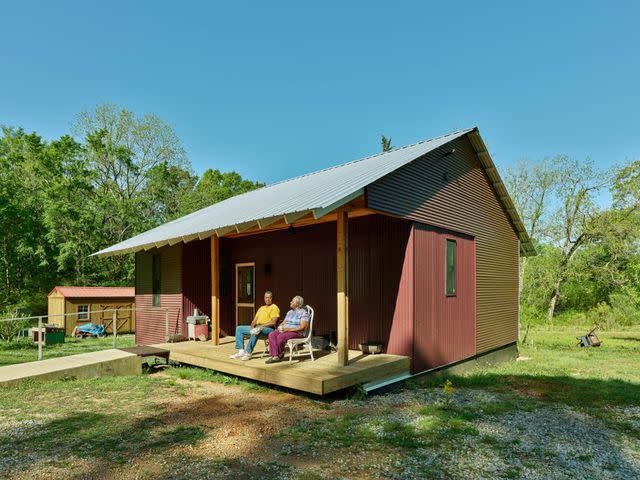
Timothy Hursley
One of Rural Studio's most common building projects are 20K houses for local families.“We started with building houses for individuals, which is one way to keep someone in the rural setting that they want to live in—a place that is their homeland,” McGlohn says. “But once you look at outside factors, you realize there’s so much more. In this case, if you don’t have a way to flush the toilet, you can’t stay where you want to live anyway. So we’re finding partners to help us solve those problems.”
The county is strengthened by these projects, which have included a library, a town hall, recreation centers, and parks—all made by young architects in training. And dozens of local families now own and live in low-cost homes. What began in 1993 as a challenge to craft attractive yet energy-efficient houses on a budget has blossomed into the Front Porch Initiative, where partners from across the country are uniting to find scalable solutions for the affordable-housing crisis.
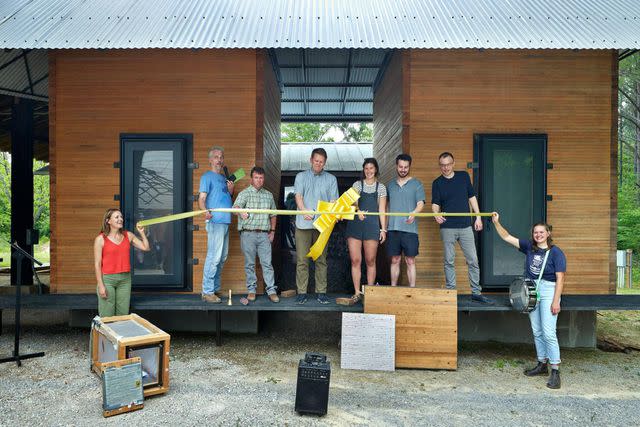
Timothy Hursley
e Breathing Wall Mass Timber Research Project allowed students to explore how structural design could impact energy use.Educating Young Architects
But at its core, Rural Studio is about education. “Architecture students normally draw things and then have this kind of game with their professors,” Freear says. “Here, there’s something at stake. These folks get to actually make something, and they start to understand how difficult it is [to implement their plans]. Not only that, but we genuinely ask them to think about the way they want to lead their lives in the future and the type of architects they want to be.”
Third-year students collaborate on a single project, often a house for a family in the area. The past several classes have been committed to finishing Rosie’s Home, a multiyear venture for a local couple that is aimed at exploring intergenerational living and structural longevity. It’s done in the style of a pole barn, where new rooms can easily be added to expand its footprint without compromising its integrity.
Fifth-year students attempt to complete an entire project (from fundraising and research to design and finally construction) within the year. The latest cohort is creating a new set of bathhouses for the Rural Studio campus as well as an 18- by 18-foot multistory home for a local pastor. Although they graduated college in May, all have stuck around to see their designs realized—earning them the lauded nickname “the leftovers.”
“I kind of drank the Kool-Aid, but you get much more invested in these projects than you ever would [elsewhere],” says former student Meagan Mitchell. “It’s a good practice to be this invested in your work.”
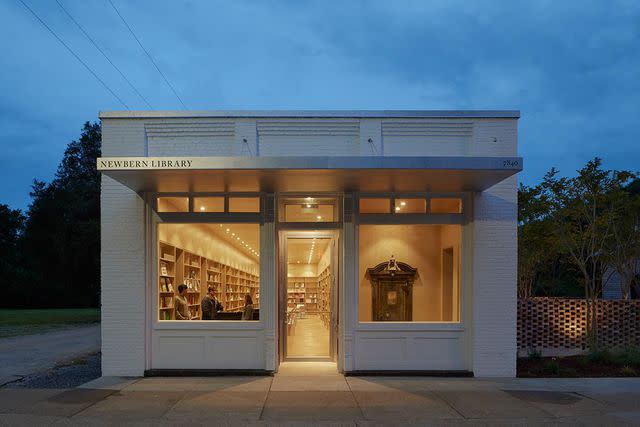
Timothy Hursley
A former bank in downtown Newbern was turned into a library in 2015.A Tight-Knit Family
Nearly all Rural Studio faculty and staff reside full-time in Newbern, Greensboro, and the surrounding area. And since amenities typically found in bigger cities are limited (the closest Walmart is about 25 miles away in Demopolis), it’s a considerable decision to make. “Everybody who works here is snakebit,” McGlohn says lovingly. “I don’t think you could do this unless you were.”
The people who have been through this experience and have lived in this place always seem to find a way back. McGlohn’s journey with Rural Studio started when she was a college sophomore in 1999. She continued with the program during her fifth year in 2002 and stuck around until 2006 before leaving and then returning to be a full-time instructor in 2017. The same goes for communications manager and alumnus Natalie Butts-Ball, who moved back to Hale County in 2012, bringing along her now-husband, Eric Ball, to run the Rural Studio farm. John Marusich, who met his wife here as an undergrad, also couldn’t stay away. He joined the team in 2022 as a lecturer and design-build manager.
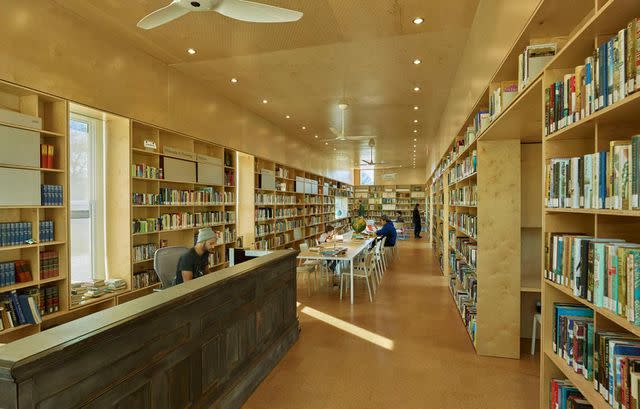
Timothy Hursley
The Newbern library, built in 2015, provided the first public internet point in the community.Rural Studio is as much a part of the community as the community is a part of it. On any given afternoon, you can find Butts-Ball and her three kids checking out books in the Newbern Library, which was completed by the graduating class in 2015. Freear, who serves on the library’s board, will pop in for early-morning meetings, and throughout the day, students trickle in and out searching for a quiet place to perfect their renderings. Over the years, the studio has received global acclaim for its novel approach to rural construction, for its creative use of unconventional materials, and for its beautifully designed buildings. But none of those accolades come close to its biggest accomplishment.
“When I first arrived, there was a lot of suspicion of academics—that we would come out to do our research, leave to get our tenures, and then disappear,” Freear says. “But we all live out here, so these are our neighbors and our friends, and that’s a big deal. What we’ve achieved is only possible because we’ve been digging in for 30 years and have really made a commitment to this place.”
Explore Hale County
Take a tour of Rural Studio’s expansive body of work by visiting these landmark structures
Newbern
The main drag is about a half mile down the road from Rural Studio. This small outcropping of buildings includes the Newbern library, fire station, and town hall (all student projects). While you’re there, stop into Newbern Mercantile for the blue plate lunch special.
Greensboro
Start your visit to “Alabama’s Catfish Capital” in downtown Greensboro by marveling at the gorgeous jasmine-covered walls of Project Horseshoe Farm’s courtyard, which Rural Studio completed in 2021. Pick up a slice of pie at The Stable cafe, and then go about a mile south to Lions Park. Its 40-acre grounds underwent a 10-year student-led transformation. Points of interest include the whimsical shade pavilions, a playscape constructed of galvanized drums, the timber-lined Lions Park Scout Hut, and a skate park funded by Tony Hawk. From there, take a five-minute drive to the Safe House Black History Museum, located in the home Martin Luther King Jr. once stayed in while hiding from the Ku Klux Klan. Rural Studio restored the exteriors of shotgun houses on the property, one of which now serves as a gallery for African American art.
For more Southern Living news, make sure to sign up for our newsletter!
Read the original article on Southern Living.

